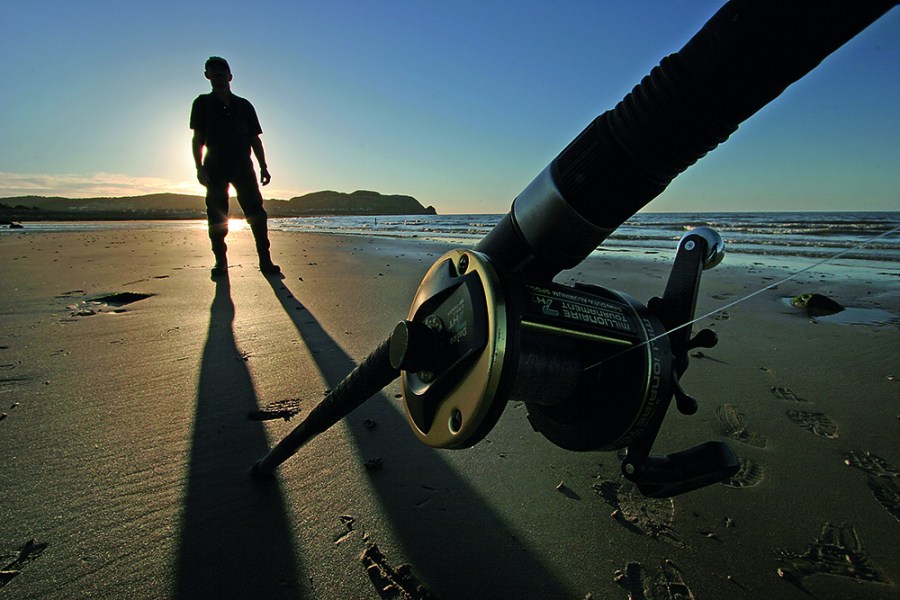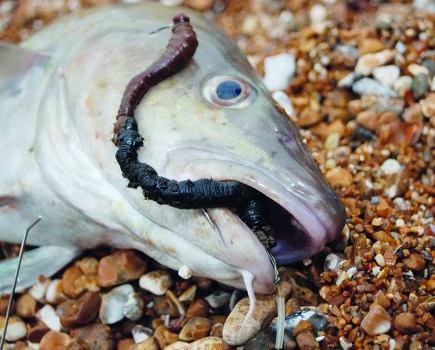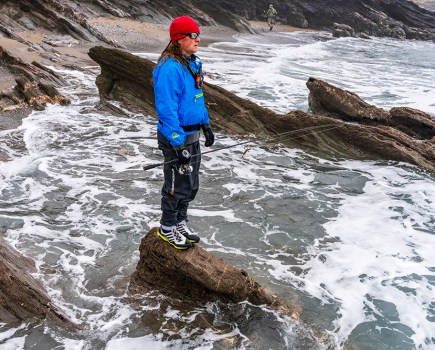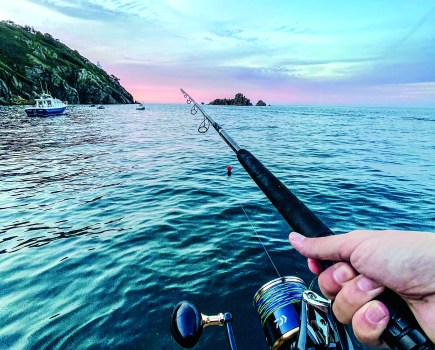Many years ago, on fine summer days when the height of the tide was just right, the old road bridge crossing the Loughor Estuary was packed with anglers fishing shoulder to shoulder attempting to catch the grey mullet which packed the holding pools just down-water from the bridge. It was common practice to load a silver Mepps spinner with bunches of maddies and allow the force of the ebbing tide to lift the bait just below the surface, tempting the mullet to take the juicy offerings. More often than not, most of the anglers caught a fish or two except for one regular participant who never caught any. His nickname was Dai Lightening, so named because of his propensity to strike. Dai would constantly lean over his fishing rod, legs astride waiting to pounce whenever he thought he had a bite. With a wide, sweeping movement he would dramatically swipe his rod backward over his head simultaneously shouting “fish on, fish on” and darting backward into the roadway, endangering both himself and the passing motorists – his lead weight often flying alarmingly backward over our heads.
Dai’s behaviour was a perfect example of how not to strike a fish. We have all been there: a rod tip continuously knocking furiously or displaying small, regular, jerking movements over and over again. Convinced that we have captured our target fish, we excitedly retrieve the line in anticipation of a prized catch only to discover that our hopes have been dashed. It’s a miserable, disheartening feeling not helped by the fact that we can’t explain why we have blanked after such positive indications that we have secured our prey. I have always naively believed that if the rod tip signifies a positive bite then a fish has taken the bait into its mouth, but this is not what necessarily happens at the “business end.” The rod tip frequently vibrates because of a variety of other reasons. With the exception of wind, weed, current or crabs, what else could be causing such animated movements of the rod tip?
When a fish first detects an object, even one off to its side, it will turn and face it in order to examine it. This enables the object to be brought within the narrow range of the fish’s binocular vision. Fish are near-sighted and focus on objects much nearer to their eyes than humans do and will often approach very close to their intended prey to inspect it, frequently making accidental contact with the bait or lure in the process. Dependence on sight varies greatly in fishes and a general clue to the use of the eye is its relative size. Eyesight in fishes such as bass that feed both during daylight and in darkness have prominent eyes with a diameter equal to about one fifth the length of the head.

SUPER SENSORY
Despite this variation in the size of their eyes, the majority of fish species see colours in much the same way as we do and associate certain colours with bait acceptability closely related to natural foods and have developed eyes that will detect the type of colours typical of their environment. For example, inshore fish have good colour vision whereas offshore oceanic species have limited colour vision and detect only a few if any colours other than black and white. Sharks do not see colour because they feed primarily by smell and can no longer locate any food if their nostrils are experimentally blocked by cotton wool. Pure water is blue, the Mediterranean looks blue because it contains very little colouring matter unlike the waters that surround the UK which contain various colouring agents mainly vegetable decay products that stain the water a green colour and subsequently influence the colour seen by fish. The colour red elicits the strongest response from bass. Yellow is the next most important colour for this species. On one occasion whilst observing a shoal of small bass swimming just below the surface in Swansea marina, I witnessed several of them brushing their sides against the many red and yellow beads which adorned my snoods whereas my worm bait appeared not to interest them at all. This behaviour caused the rod tip to vibrate energetically but this stopped when I changed to blue and green beads.
This buffeting of the coloured beads is because in fish, taste buds are not restricted as they are in mammals to the tongue and pharynx but may occur all over the body which is why some species are able to turn and snap at bait located near the tail. Touch is well developed in fish with sensors not only around the mouth but as modifications of the fins, a good example are the pectoral fins of gurnards. Such an arrangement must give a broader area for the selection of food than if the taste receptors were restricted to the mouth or on the head. Furthermore, the lateral line system of receptors running along the side of the fish provides a system touch wholly outside our experience and is used to assist in prey detection.
FALSE BITES
Like those of humans, fish retinas possess both cones for colour vision as well as rods for black and white vision. During daylight, fish use primarily cones for vision. At night the rods, which provide much higher light sensitivity and resolution are used instead. The process of switching between using cones instead of rods (and then back again) may take up to two hours. Although the eyes of predatory fish adjust more quickly than those that feed on marine vegetation they become more hesitant in conclusively taking the bait during dawn and dusk which although this is the optimum time for catching fish. Some anglers comment that this is also the time when they get the greatest number of “false” bites.
Once food is found it usually requires positioning or preparation prior to swallowing, causing vigorous movement of the rod tip. Several fish species swim about with the bait in their mouths shifting it until it is positioned so that it can be easily taken into the back of the mouth, usually with the head toward the throat if the bait is a smaller fish. Some species even chew or crush their prey before swallowing it and then move off.
Not all materials taken into the mouth are swallowed immediately or sometimes even at all. Bait taken only by sight must be tested for suitability by sensory receptors inside the mouth, many bottom feeding species take in various incidental material with their food and subject it to a selection process inside the mouth. In many instances such unwanted material is rejected through the gill openings after having been subjected to a final test by taste. Large particles are usually ejected through the mouth with a vigorous “coughing” action.
BAIT SIZE
The size of the bait is particularly important in some species but not in others, such as cod, which will take bait from 2mm up to a size that is too large swallow. In a number of species, bait shape is also of great importance. Fish of some species snap more often at food of a certain shape than at others. Extensive studies have shown that star-shaped objects are seldom chosen and seem to cause avoidance in several species. Sometimes, food too large to swallow can be set upon by two or more fish each struggling to get its share so that the food is first reduced to pieces that can be ingested. If what remains becomes remotely star-shaped, the nibbling fish will ultimately move away thereby bringing the rod tip to a standstill again.
Feeding habits in various species show that small individuals consume more per day in relation to their bodyweight than large individuals. Small fishes of 2g to 5g eat the equivalent of 6 per cent to 10 per cent of their body weight per day while fishes of 30g or more consume food of only 2 per cent to 3 per cent of their body weight. This is one reason why we see so many relatively small fish struggling to consume bait which is much too large for them to grasp, chew and swallow so after several failed attempts to take the bait, they ultimately leave it and move away.
Combining sucking with grasping increases the range in some species so that they can then bring food to the jaws from further away. This is achieved by suddenly opening the mouth and enlarging the cavity at its back. Development of jaws that allows great extension of the mouth beyond the usual profile of the head or by the perfection of long tubular mouths leads to bait being sucked and moved through the water before it is indeed ingested into the mouth itself.
FRESH BAIT
Fishes other than sharks and rays are known to be greatly attracted to bait food by the sense of smell. These are predominantly but not exclusively eels, wrasse and cod. Flesh rotted to foulness has been shown to repel some species so that a fish that starts to nip at a bait may ultimately leave it alone the longer it spends around bait which is not fresh and has decomposed too much. This is why fresh bait should be used whenever possible. Although fish can detect others of the same species by their sense of smell, this does not prevent them from eating their own kind although this happens predominantly when the prey fish is already dead. Exceptionally, parent-offspring cannibalism has been increasingly reported in live specimens amongst the common goby.
There will be instances when a relatively small fish which has already attached itself to the bait is spooked by a larger fish, leaves the bait alone only for the larger fish itself to become disinterested and also abandon the bait.
When some predatory fish strike a bait, particularly a live one, they will typically do so in two motions. They will firstly attack and frequently inhale or suck the bait, back away, turn then inhale and swallow the entire bait. This leads to intermittent knocking of the rod tip.
Some of these factors need to be borne in mind in deciding whether we allow more time before we retrieve our line in response to a moving rod tip and whether or not we strike energetically or not at all. Of course, some of these become less relevant when fish are engaged in frenzied gorging associated with intense competition for limited food. Under these conditions they will smash into, hit and swallow, the bait in an instant. Some species do this at incredible speed. The fastest swimming species in UK waters are mackerel which are able to swim 50 meters in 10 seconds.
To strike or not to strike is one of the most enduring and polarising issues between anglers. There’s no hard-fast rule one way or the other. However, there’s one thing we need to bear in mind which is that no one can provide a shred of evidence that striking a rod leads to the capture of more fish than not striking it. Had this occurred to Dai Lightening, his catch rate may well have improved to include a grey-coloured piscine bolt from the blue.
10 TOP TIPS ON HOW TO INCREASE HOOK-UP RATES
- Resist the temptation to strike too early. Allow adequate time for the target fish to take the bait thoroughly.
- Allow more time for the fish to take the bait during the hours of dusk and dawn because these are the periods of vision adjustment.
- Avoid striking too hard or too recklessly – you may tear the hook out of the mouth of the fish, damage the rod / reel or snap some crucial knots.
- Most sea fish will eventually hook themselves eventually, even in the absence of a strike, simply because they are intent on eating the bait and are oblivious of all else.
- Use brightly coloured red or yellow attractors such as beads, sequins, spoons, blades or lures.
- Avoid the use of stale, rancid or rotting bait. The fresher the bait, the better the catch-rate.
- If you detect a second bite following a delay of two minutes or so after the first bite you can be reasonably sure that the fish has taken the bait properly. This is probably because the fish has satisfied itself that the bait is acceptable.
- Try and adjust the size of your bait according to your target species: cod, conger eel, bull huss, or tope will happily take big bait and swallow it all whereas mullet, most mini-species, Dover-sole and garfish should be tempted with smaller sized baits.
- Change your bait frequently to ensure an effective scent trail. This will enhance the willingness of the predatory fish to take the bait when it reaches its target.
- Whenever possible, hold the rod whilst trying to confirm whether the fish has indeed taken the bait. With practice and experience, many anglers can reasonably predict what species are at the “working end” of the line, particularly if the line is braid which does not stretch thereby offering far better bite detectionmeaning that even bites from small fish are easily recognisable. Seasoned anglers are also able to distinguish between a genuine fish bite as opposed to a twitching rod-tip induced by weed, current, or crabs, for instance.


 Dr Roger Munro
Dr Roger Munro




